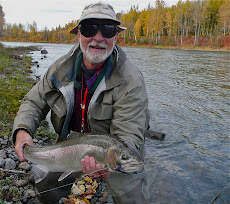Hi Everybody!
Here is a link to a neat piece of video from Monday night when we tied the Charlie Boy Hopper and Turck's Tarantula:
http://www.youtube.com/watch?v=IpFw_gRvoec
Thanks to Randy from the Advocate for putting the piece together.
Bob
Wednesday, February 24, 2010
Monday, February 22, 2010
Monday February 22, 2010
Hi Everybody!
I always have a plan B "in the box" and tonight we used it. Tonight was Don Andersen's night but he was out of commission recovering from surgery. I hope you are back in the shop working on your bamboo rods, Don, in the next few days. We missed your left handed tying and tall tales, Don.

We did have a visit from Bonnie and John Howard tonight. They own Howard's Hackle. John and Bonnie brought an incredible variety of quality hackle for the gang to check out and purchase. John and Bonnie spent the evening with us seeing what we do on Monday nights. John took some time to tell us about the family business that has evolved over several generations. It's neat to hear about a successful business related to our club right in our backyard! Take a visit to Howard's Hackle.

25 tyers spent the evening tying Charlie Craven's "Charlie Boy Hopper" and Guy Turck's famous Turck's Tarantula. Both flies are great floating patterns that can be very productive during both golden stone hatches and hopper season.
Next week Les Kolibaba is our guest tyer. Les is all organized, keen and ready to go! See you then. We only have three tying sessions left.
Oh yes, Happy Birthday Joseph!

Bob and Byron tying (I think the Flames were playing)

Charlie Boy Hopper
(Charlie Craven originator)
see here for the tutorial to tie this pattern:
Hook: 3x dry fly sizes 4 to 10
Body: craft foam
Legs: Silly legs or equivalent
Wing: Deer hair

Turck's Tarantula
tutorial here:
Hook: Tiemco 5262 sizes 2 to 14
Thread: 3/0 or 6/0 tan
Tail: Amherst or golden pheasant tips
Body: Golden stone dubbing or hare's ear
Underwing: Pearl Krystal Flash
Overwing: White Calf Tail
Collar: Deer hair tips
Legs: Medium rubber or silly legs
Head: Spun and trimmed deer hair
Monday, February 8, 2010
Monday February 8, 2010
Mysteries of the Royal Coachman
Twenty keen tiers spent the evening learning about a fly that has its origins back in 1878. The Royal Coachman was first tied by John Haily, a professional tier who was employed by Charles Orvis. The pattern is a variation of an older British pattern, the Coachman, which was tied by Tom Bosworth, a coachman to royalty. Once a wood duck tail and a red band of silk was added, the more durable fly was renamed by Charles Orvis to be called the Royal Coachman. The Royal Coachman is an attractor pattern that has stood the test of time. As Doug pointed out, " Sometimes tradition and prettiness will triumph over technology and entomology."
We certainly appreciate the preparation you put into this evening's tying session Doug! It was enjoyable. Your detailed notes will be a great reference in the future.
Just a reminder that there is no tying session on Family Day. Our next session is February 22nd when Don Andersen is our our guest tyer. Don maybe the dean of stillwater fishing in Central Alberta. This is an evening you should not miss. Just before Don starts his presentation: John Howard, from Howard's Hackle, will be at Annie L Gaetz with hackle to sell. If you have some specific needs, contact John and he will bring your order. He will have beginner packs, quality dry fly hackle and streamer packs. Check the link on our blog to see what he has available.
Finally, our trip to the Parkland Region of Manitoba is now full. It's going to be a fun educational trip!
Bob

Doug Pullen

The 'Gang" learning about the historical Royal Coachman.

Royal Coachman "wet"
Hooks: Wet fly hooks sizes 8-12
Thread: Black 8/0
Body: Peacock herl with red floss in the middle
Tail: Tippets from golden pheasant
Hackle: Throat-brown hackle barbs
Wing: White Mallard Wing

Royal Emerger (originator Vladimir Markov)
Hook: TMC 2487, Mustad 80250 or TMC 200R, sizes 10 to 14
Thread: Black 6/0 or 8/0
Tail: 4 to 6 Black Hen hackle fibers
Nymphal skin: Red Antron yarn, sparse
Nymphal Thorax: Peacock herl
Body of Dun: Red floss
Thorax of Dun: Peacock herl
Hackle: Coachman brown hackle
Wing: White hen hackle tips

Royal Wulff
Hook: dry fly, sizes 2 to 20
Thread: White then black to finish off the head
Tail: Deer hair
Body: Peacock, red floss and peacock in equal sections
Wings Calf body or tail hair
Hackle: Brown
Head: Black thread
Monday, February 1, 2010
February 1, 2010
Hi Everybody!
Reid Stoyberg was our guest tyer tonight. Reid taught 22 tyers how to construct both a caddis emerger and a caddis pupae. Reid has successfully used both patterns on local lakes. Reid's flies are based on Davie McPhail's pattern. You can see his videos on Youtube (see the previous post). Reid made some adjustments to his patterns based on his observations of the emergers and pupae at local pot hole lakes. Reid's presentation was simply outstanding. He was well prepared and his instructions were very detailed. We were all impressed, Reid! Imagine, a seasoned veteran at 16 years old.
Next week Doug Pullen is our guest tyer. Doug has a neat theme planned for us. See you there!
We have two spots left for the trip to Manitoba. Let me know if you want to go.

Reid Stoyberg

Caddis Emerger
Hook: Tiemco 2457 sizes 6 to 16
Thread: Orange 8/0
Rib: Organza ribbing
Body: brown seal dubbing (or substitute)
Thorax: Cream dubbing
Wing: Brown dyed deer hair
Head: orange or amber dubbing

Caddis Pupae
Hook: Tiemco 2457 sizes 8 to 18
Thread: Orange 8/0
Rib: Uni mylar
Body: Brown dubbing- seal is best
Hackle: Partridge
Thorax: Peacock herl

Subscribe to:
Posts (Atom)








